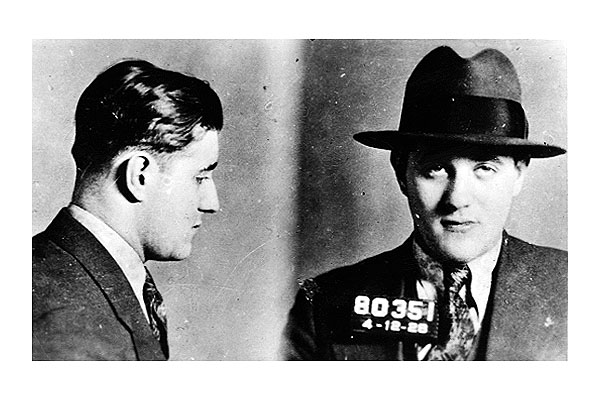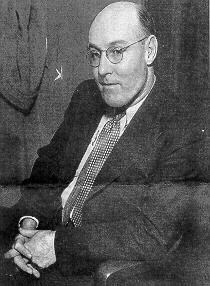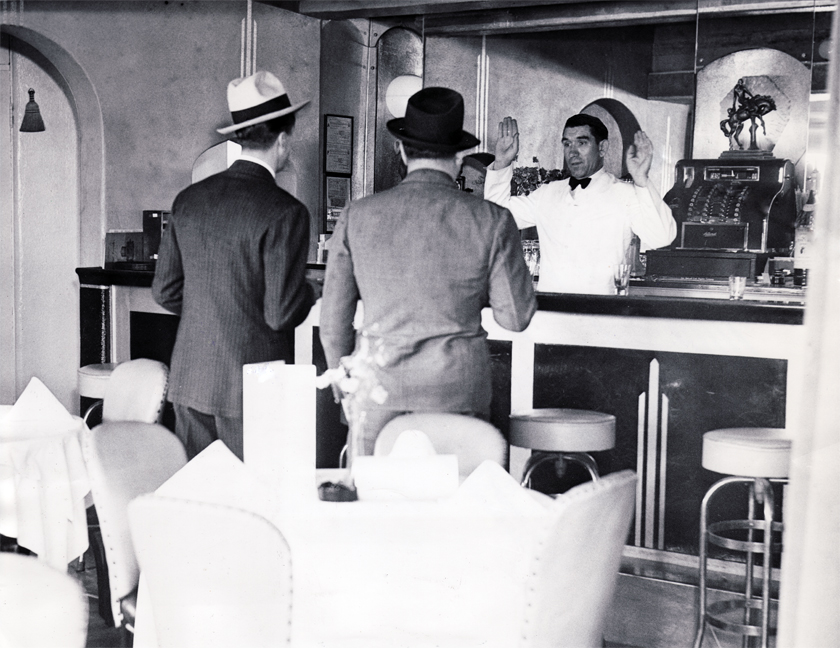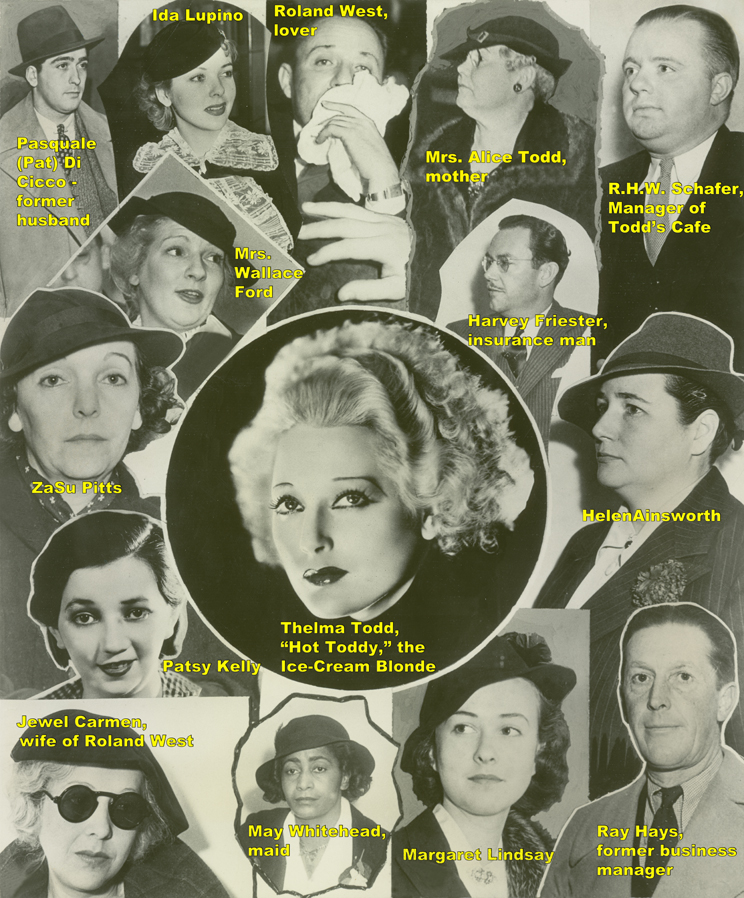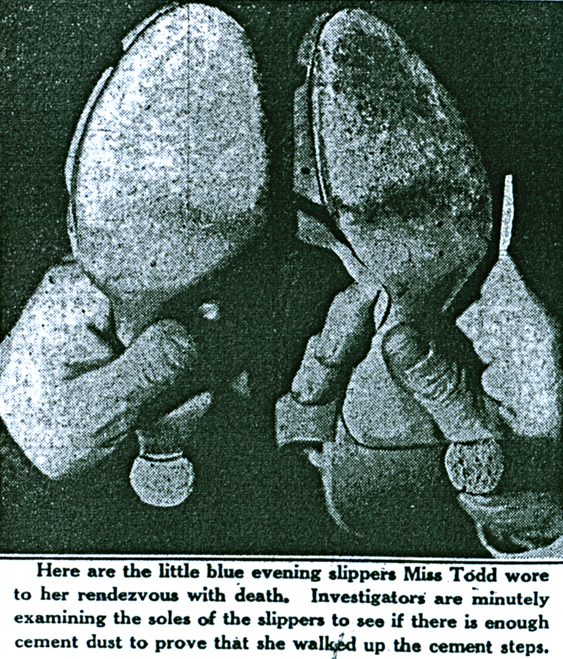
Weaving true crime into fiction
|
||
|
Mug shot of Bugsy Siegel In the July 1946 issue of "Pageant Magazine" (v2 #6, Pgs 126-129, "He Makes Murder Pay") Irving Wallace wrote the following about Raymond Chandler: "In creating situations and drama for Marlowe, Chandler often starts from a true story he happens to overhear." He goes on to quote Chandler: "I learn something too hot for the papers to publish," ... "and it starts me thinking and then my imagination takes over." Wallace further writes: "It is said that his first novel [The Big Sleep], revolving about a fat homosexual who ran a rental library of pornography, had its basis in unprintable fact." Maybe unprintable in 1946! Keep in mind that the Hurst Papers got a photographer into the 1935 Todd Funeral and printed a picture of her in her coffin. Don't offen see that even today, when just about everything is fair game and unprintable in 1946 would now be tame. Over the years many have assumed that Stanley Rose and his bookshop were the inspiration for Giger's Rare Books and porn lending library. They forget that there were about 30 book stores along Hollywood Boulevard in those days. Chandler frequented the Stanley Rose Bookshop, along with the other Black Mask writers. They gathered in the back room of the bookstore to drank and socialized. If the writers were in the back room, where was the porno rental library? No, the inspiration probably wasn't Stanley Rose's bookstore, although Chandler could have woven Rose's look and feel into Geiger's. Chandler undoubtedly heard something "unprintable" that sparked the idea for "The Big Sleep." Here then, minus the back story to "The Big Sleep," are some of the real events Chandler undoubtedly knew about and wove into his fiction. The Doheny mess! In an essay from "Raymond Chandler, A Literary Reference," and on his web site, Robert F. Moss discusses the real life story behind the High Window's Cassidy Case. It is an excellent review of the facts surrounding the murder-suicide of Hugh Plunket and Ned Doheny, or Ned Doheny and Hugh Plunket in the Doheny inspired official version, on February 16th 1929, and a back story you should read. If you would like to get the scoop from the source, you know, get the "411" from Leslie T. White, the detective from the Bureau of Investigation, LA County District Attorney's office, who was the "CSI" that investigated the murder-suicide, here is the whole 9 yards! (Chapter 18 from "Me, Detective,") as a PDF file. However, in a nut shell, called to the scene at 2 am, White gathers evidence, takes pictures & fingerprints, then attends the autopsies. He notes and concludes: There were NO powder burns around Hugh Plunket's wound - thus he was shot from a distance (that is, he couldn't have shot himself!). FYI, this picture hasn't been seen since 1929 and didn't make it into White's excellent book, "Me, Detective,"; There WERE powder burns around Ned Doheny's wound - Ned, actually the last one alive, did shoot Hugh and himself. FYI, this picture of Ned Doheny did make it into "Me, Detective,", but 8x10s of it and the one of Hugh were won on an eBay auction and probably came from the estate of someone who had access to the original crime scene photos; A strange pattern in the blood on Ned Doheny's face and head - a result Ned's body being moved; He concludes Hugh Plunket didn't kill Ned Doheny then himself; He further concludes something is "warped about this case." "The Teapot Dome Scandal," by Laton McCartney will fill you in on the complete back story to the political shenanigans that may have led to the murder-suicide. Ned Doheny and Hugh Plunket were the "bag men" for the senior Doheny's bribe of Albert B. Fall, Warren G. Harding's Interior Secretary. Ned and Hugh shared the downstairs room where they died while Ned's wife stayed upstairs. Hugh was also Ned's traveling companion on business and pleasure trips. Were they homosexual lovers? Was there a fight about the upcoming testimony that could send Doheny senior to jail? If you think politics stinks today, this book is a must read! Needless to say, Doheny senior didn't go to jail! The location of Edward (Ned) Doheny Jr's death is the Greystone Mansion, 905 Loma Vista Drive in Beverly Hills. Edward Doheny senior bought 429 acres in Beverly Hills in 1910, after striking oil in the 1890s. In 1914 he gave a 22-acre plot to his son Ned as a wedding present. Ned and his wife left the land alone until 1925. The house took three years to build and cost 3.1 million dollars. In September of 1928 the family moved in. It is a 55-room 46,000 square feet Tudor mansion, currently on 16 acres. Ned's widow lived in the mansion until her death in 1955, when Greystone and the grounds were eventually deeded to the city of Beverly Hills. It is now a Beverly Hills Public Park, and location for special events. Numerous films and TV shows have been filmed in the mansion and on the grounds. The senior Doheny lived in a mansion near USC, in the Chester Place gated community, part of the Historic West Adams district along West Adams Blvd just West of Figueroa street. That mansion is now part of the Doheny Campus of Mount St. Mary's College. If you live in Los Angeles or visit, Greystone is a must see. Benjamin "Bugsy" Siegel as Steelgrave of "The Little Sister" Mr. Moss also tackles another bit of Chandler lore regarding Benjamin "Bugsy" Siegel, assumed to be the model of the Steelgrave mobster character in the novel, "The Little Sister," citing a November 19th, 1940 Los Angeles Examiner front page expose as proof. Siegel, who had been arrested in August of 1940 for the murder of Harry Greenberg (for conduct unbecoming a mobster), received many perks while in jail, as well as passes to leave the jail, which he did some twenty times. Eventually the press caught the whiff of scandal and Siegel, tailed by an Examiner photographer (the Hearst morning Examiner newspaper), was photographed leaving Lindy's Restaurant, in the mid-Wilshire area where he had just lunched with actress Wendy Barrie. A Paris Hilton type flap ensued and the county jail doctor who wrote Siegel's passes, and received some $130,000, was fired. In "The Little Sister," Philip Marlowe is engaged by a "prissy-looking girl" from Manhattan, Kansas to find her missing brother. Marlowe soon discovers there's another sister, an aspiring actress named Mavis Weld. The plot involves blackmail, loose women - it is Hollywood after all - mobsters, dead men, including the missing brother, and, as usual, Marlowe bending the rules to help his client. The missing brother takes pictures of his actress sister lunching with Steelgrave when he also was supposed to be in jail, his alibi for the period when a rival was murdered. Sound familiar? The photos, used for blackmail, get the brother killed, could ruin the sister's career, and put Steelgrave in the Gas Chamber (the method used in California after 1937, although the last hanging was in 1942 - my grandmother witnessed a public hanging in Los Angeles in the early 1900s). Siegel is often credited with creating Las Vegas. His local mob boss Jack Dragna, and the Chicago Mob, which funded his Las Vegas casino (The Flamingo) suspected he was stealing from them because of the many trips his wife Virginia Hill made to Zurich, Switzerland. Eventually Bugsy's womanizing drove Virginia to a Reno divorce and then to Europe with his, and the mob's money. That sealed his fate. At 10:45 PM on June 20, 1947 a mob hit man, using a U.S. Military M1 Carbine, shot Siegel many times as he sat reading the Los Angeles Times in Hill's Beverly Hills mansion at 810 N. Linden Drive. One of the bullets smashed the bridge of his nose, blowing his left eyeball out of its socket and 14 feet away, where it was found intact. Exit one more mob Sociopath for conduct unbecoming. Bumping off George "Les" Bruneman
Chandler never wove George Bruneman into his fiction, although he probably read about him, and his knowledge of the Los Angeles mob and their language and exploits did play a part in his writings. I added Bruneman to the true crime page because I came across an old International News Photo stamped "Received Examiner Reference Library JUL 11 1938." A Note on back reads: "Hunt For Les Bruneman, Gambler, Reenacted Los Angeles, Calif.: (Above) Doc Puccinelli, proprietor of fish house, reenacts scene when killers walked in with drawn guns in search for Bruneman the night before he was killed. 'This isn't a hoist,' they told him. 'Put your mitts down. We're lookin for a guy." Bruneman had just left the place a few moments before. 7-8-38. Here is the photo:
So much for reality TV and reenactments being new! An ally of Jack Dragna and Johnny Roselli, Bruneman got into trouble for repeated encroachments on their gambling and race wire concessions. Bruneman also defied a Bugsy Siegel request that all independent operations make a 10% contribution to the New York mob. Finally, after Bruneman threatened the life of Johnny Roselli, Dragna put out the contract on him, which was fulfilled on October 24, 1937 by Leo "Lips" Moceri and Frank Bompensiro. Dr. George K. Dazey proves Hell has no fury like grandparents scorned In the March 1989 Los Angeles Magazine article entitled "The True Story! How the notorious '40s murder trial of celebrity doctor George Dazey became the basis of Raymond Chandler's greatest novel," by Patrick Jenning; Jenning asserts that the Dazey case, and not the death of Thelma Todd, was the "true crime" behind Chandler's novel, "The Lady In The Lake." I'll leave the assertion that "The Lady In The Lake" was Chandler's greatest novel to the critics. As to Dazey, this is the story: On the evening October 3. 1935 Dr. George K Dazey returned to his Santa Monica home, 255 23rd Street (now 2301 Georgina Ave), to find his 31 year old actress wife, Doris, dead on the floor of the garage, which faces Georgina. About the change in house numbers: In the early 1900s Los Angeles County cities had their own street addressing schemes. In the early 1930s the cities adopted the county method, which placed the street numbers of corner houses on the cross streets. Los Angeles changed in 1936. Of course the change only happened with existing homes when a building permit was issued, which is obviously what happened to the Dazey house, hence 255 23rd in 1935 and 2301 Georgina today. In any case, the "good" doctor found his wife on the floor of the garage in a thin nightgown near the exhaust pipe of her idling car. Police speculated that Doris had started the car, then fainted on her way to open the garage door, which was closed - more about how quickly one could be overcome by carbon-monoxide in 1935 in the discussion of Thelma Todd. Doris' father, also a doctor, supported this theory. Doris had been ill since the birth of her son in June, and had just returned home a few weeks before from a sanitarium where she had been recovering from a nervous breakdown. The autopsy revealed the death was from carbon-monoxide poisoning. A coroner's jury concluded that there was no evidence of foul play. The son, Walter, was taken by Dr. and Mrs. Schwuchow, his maternal grandparents. Dr Dazey moved out of the house to an apartment at 330 California, that wonderful Art Deco building at 4th and California, one block north of Wilshire and his second floor office in the building on the North side of Wilshire at 4th street that currently houses a T-Mobile store. For four years nothing happened. Then Dr. Dazey married again, for the third time. 37 year old Hazel Dorcas Timmons was the lucky lass, or maybe not. Not long after the wedding they took Walter from the doting grandparents, who did not want to give him up. Walter bounced back and forth for a bit, but in September 1939, Dazey refused to give him to the grandparents for the weekend, and with that, as they say, all hell broke lose! Dr. Schwuchow was furious and warned Dr Dazey he'd be sorry. And he was, because in December 1939 he was arrested for Doris' murder. I guess there is nothing like grandparents scorned! The trial opened on February 6, 1940. Dr. Dazey was represented by legendary Los Angeles lawyer Jerry Giesler, who over the years represented Alexander Pantages, Errol FLynn, Bugsy Siegel, Edward G. Robinson Jr., and Robert Mitchum and much of the Hollywood elite, etc. It was the Simpson trial of early 1940s Los Angeles. The DA said the motive for murder was Doris' suspected infidelity and Walter's paternity. The case relied on Mary Bates, a maid who claimed to have worked for the Dazeys, Winifred Hart, ex-wife of cowboy star William S. Hart, a teenage neighbor, Doris' sister, Frances Hansbury, Dazey's ex lover and Roland De Witt Seal, operator of a private security patrol. Giesler unmasked them all. Hansbury was jealous, had threatened to get even with Dazey, threatened his other lovers, and was staying with Doris' parents. Mary Bates lied, had never worked for the Dazeys, wasn't even in California before Doris' death and changed the date on evidence - a letter. She was later convicted of perjury and given three years probation. Seal also lied, although he was never prosecuted. Closing arguments took 10 days. Giesler called the prosecutions witnesses ghouls, vultures and vampires in human form. The DA pointed out that Dazey's story changed with every telling. In the end the doctor was acquitted, but his troubles weren't over. The Schwuchows sued for custody of Walter. Hazel divorced him. Then Dr. Schwuchow died and his wife remarried. In 1942 Dazey gave Walter to his grandmother. In 1943 George Dazey died from complications of pneumonia. A lot of the facts of the Dazey case do match elements of the novel, "The Lady In the Lake." However, so do the facts surrounding the death of Thelma Todd, Hot Toddy as she sometimes called herself. Both women died in late 1935, Doris in October and Thelma in December. Both were actresses, Doris in the Ramona Pageant and Thelma famous for her work with the Marx Brothers, etc. Both were relatively young. Both were ill and possibly prone to fainting. Both died of auto related carbon-monoxide in closed garages just a few miles apart. Both cases involved night watchmen and maids, and the publication of the novel came on the heals of Dazey's death. However, in a 1951 letter to Leroy Wright regarding a disallowed 1945 tax refund, Chandler described how he worked on multiple project over a period of years. He also wrote that "The Lady In The Lake" was "based on two novelettes called 'Bay City Blues,' published in June, 1938, and 'The Lady in the Lake,' published January 1939." This was months before the facts surrounding the Dazey case hit the news stands, and unless Chandler had a crystal ball, there is no way he could have based the short story "Bay City Blues" and Dr. Austrian on the Dazey case, since the facts weren't know until 1940. As Violets M'Gee described the case to Johnny Dalmas, the hero/detective, it was a "monoxide Dutch, ... A blonde bim named Austrian, wife of a doctor down at Bay City ..." Certainly Chandler could have embellished the novel with items from the Dazey case, but not the underlying short stores. Further, since he worked on many items over a period of months or years, "Bay City Blues" was probably being worked on in 1937. On the other hand, elements of Thelma Todd's 1935 death, especially the attention given her shoes, were in his short stories, including "Bay City Blues," and novels, as were descriptions of her Cafe and the Castellammare area of Pacific Palisades - a section of Los Angeles just north of Santa Monica. Given the similarities of the two deaths, could there have been other, earlier, yet similar monoxide deaths in closed garages that Chandler knew of? Probably, but only an exhaustive microfilm search of the Hearst Evening Hearld and Morning Examiner, and online ProQuest Los Angeles Times search would tell, and that is something I'll leave to others. So Patrick Jenning, close but no cigar! For more information on Dr. Dazey and his relationship to Mabel Normand, check out the excellent Dazey page on the Looking for Mabel Normand web site. Thelma Todd didn't get the last laugh No trial. A mysterious death. A long, long, long Grand Jury investigatio. A cast to make a novelist salivate. Rumors, lies and phone calls from the dead all make recent celebrity shenanigans and trials mere blips compared to the 1935-36 coverage surrounding Thelma Todd's death. Of course, you can't tell the players without a program, so here is a special, and rare, photo to use as a reference when reading about Hot Toddy, as her friends called her. along with a key with more details. I'm also adding a news photo of the slippers she wore, which Chandler used to good effect in "The Lady In The Lake."
On Monday Morning, December 16, 1935, May Whitehead, carrying several bundles, opened the massive wood doors of the garage on Posetano Road, high above what is now Pacific Coast Highway, and walked to her boss' chocolate-colored 1933 Lincoln Phaeton. May was Thelma Todd's maid and confidante, responsible for getting "The Ice Cream Blonde" comedienne to work on time at Hal Roach's Culver City Studio (Washington at National). However, on this morning she found Todd slumped behind the wheel, eyes closed and wearing a full-llength mink coat over a metallic blue sequined evening gown with matching cape and blue silk slippers. She was also wearing about $20,000 worth of jewelry. In fact, she was wearing her "Saturday night celebrity-studded dinner party in her honor at the Trocadero nightclub" outfit. Whitehead got back in her car and drove to Todd's cafe, below the garage on the Roosevelt Highway in Castellammare. She got Charles Smith, the cafe trreasurer and a veteran assistant film director who had worked with director Roland West for decades. West was Todd's partner in the cafe. Smith summond West and all three got in Whitehead's car and returned to the garage. West determined that Todd was dead and had Whitehead fetch Rudolph Schafer, his brother-in-law and the cafe manager, from Castillo del Mar, the hillside villa just above the garage owed by West's estranged wife, silent film star Jewel Carmen. Schafer arrived around 11:15. He touched Todd's cheek, verified that she was dead and said they had to call the police. Rather than use the phone in the villa or at the cafe, Schafer took West's Hupmobile, parked next to Todd's Phaeton, and drove several miles to a print shop in Santa Monica. He called LAPD's West LA Station on the shop owners private line. Capt Bert Wallis, head of the LAPD homicide squad later stated that "There were only 2 and one-half gallons of gasoline in the 20 gallon car tank. The garage door was closed but not locked. The battery on the car was dead. This would happen if the motor had been running and stopped. The ignition still being on, the battery would have run down." It was previously determined that the ignition key was in the ignition slot and was turned on, as if the car had been running. Next to her body was her small white party purse with a key to the outside door of her apartment on the second floor of her cafe. Her death made page-one headlines, nearly crowding the war between Eithiopia and Italy off the front page. As the investigation and Grand Jury hearings dragged on, ... To Be Continued
|
||
|
||
© 2007, 2008, 2009, 2010, 2011Loren Latker
